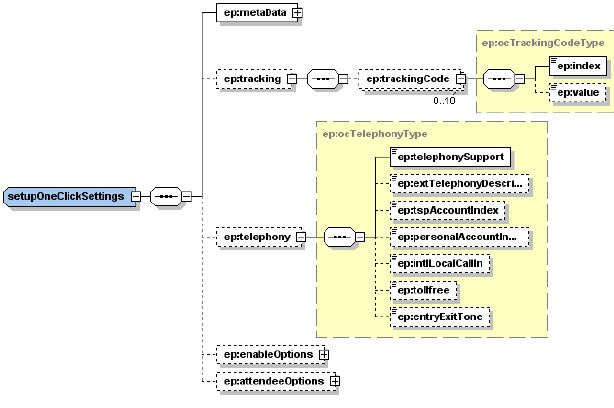SetupOneClickSettings
SetupOneClickSettings allows the one-click (OC) client to configure one click settings for a user.
Request
The XML sample is an example of a request to set up one-click settings.
<?xml version="1.0" encoding="UTF-8"?>
<serv:message xmlns:xsi="http://www.w3.org/2001/XMLSchema-instance"
xmlns:serv="http://www.webex.com/schemas/2002/06/service">
<header>
<securityContext>
<webExID>hostid</webExID>
<password>hostpassword</password>
</securityContext>
</header>
<body>
<bodyContent
xsi:type="java:com.webex.service.binding.ep.SetupOneClickSettings">
<metaData>
<serviceType>MeetingCenter</serviceType>
<sessionType>3</sessionType>
<confName>Test Meeting</confName>
<sessionPassword>654321</sessionPassword>
<listing>UNLISTED</listing>
<sessionTemplate>
<name>MC_3</name>
<type>User</type>
</sessionTemplate>
</metaData>
<tracking>
<trackingCode>
<index>7</index>
<value>test17777</value>
</trackingCode>
</tracking>
<telephony>
<telephonySupport>CALLIN</telephonySupport>
<extTelephonyDescription>TEST OTHER</extTelephonyDescription>
<personalAccountIndex>1</personalAccountIndex>
<intlLocalCallIn>false</intlLocalCallIn>
<tollfree>false</tollfree>
</telephony>
<attendeeOptions>
<joinApproval>false</joinApproval>
</attendeeOptions>
</bodyContent>
</body>
</serv:message>
The following schema diagram shows the structure of the elements in the setupOneClickSettings request message.
Figure 4-34 • Schema diagram for setupOneClickSettings
The next sample is an example of how to set up a Cisco Unified Video Conferencing (CUVC) meeting:
<?xml version="1.0" encoding="UTF-8"?>
<serv:message xmlns:xsi="http://www.w3.org/2001/XMLSchema-instance"
xmlns:serv="http://www.webex.com/schemas/2002/06/service">
<header>
<securityContext>
<webExID>hostid</webExID>
<password>hostpassword</password>
</securityContext>
</header>
<body>
<bodyContent
xsi:type="java:com.webex.service.binding.ep.SetupOneClickSettings">
<metaData>
<serviceType>MeetingCenter</serviceType>
<sessionType>2</sessionType>
<confName>valid CUVCMeetingID</confName>
<sessionPassword>P@ssword</sessionPassword>
<listing>PUBLIC</listing>
<CUVCMeetingID>${validCUVCMeetingID}</CUVCMeetingID>
<sessionTemplate>
<name>template1</name>
<type>Site</type>
</sessionTemplate>
</metaData>
</bodyContent>
</body>
</serv:message>
Response
The sample XML shows an example of a possible setupOneClickSettingsReponse message in response to the preceding request.
<?xml version="1.0" encoding="UTF-8"?>
<serv:message xmlns:serv="http://www.webex.com/schemas/2002/06/service"
xmlns:com="http://www.webex.com/schemas/2002/06/common"
xmlns:ep="http://www.webex.com/schemas/2002/06/service/ep"
xmlns:meet="http://www.webex.com/schemas/2002/06/service/meeting">
<serv:header>
<serv:response>
<serv:result>SUCCESS</serv:result>
<serv:gsbStatus>PRIMARY</serv:gsbStatus>
</serv:response>
</serv:header>
<serv:body>
<serv:bodyContent xsi:type="ep:setupOneClickSettingsResponse"
xmlns:xsi="http://www.w3.org/2001/XMLSchema-instance" />
</serv:body>
</serv:message>
The following schema diagram shows the structure of the elements in the setupOneClickSettingsResponse message.
Figure 4-35 • Schema diagram for setupOneClickSettingsResponse

